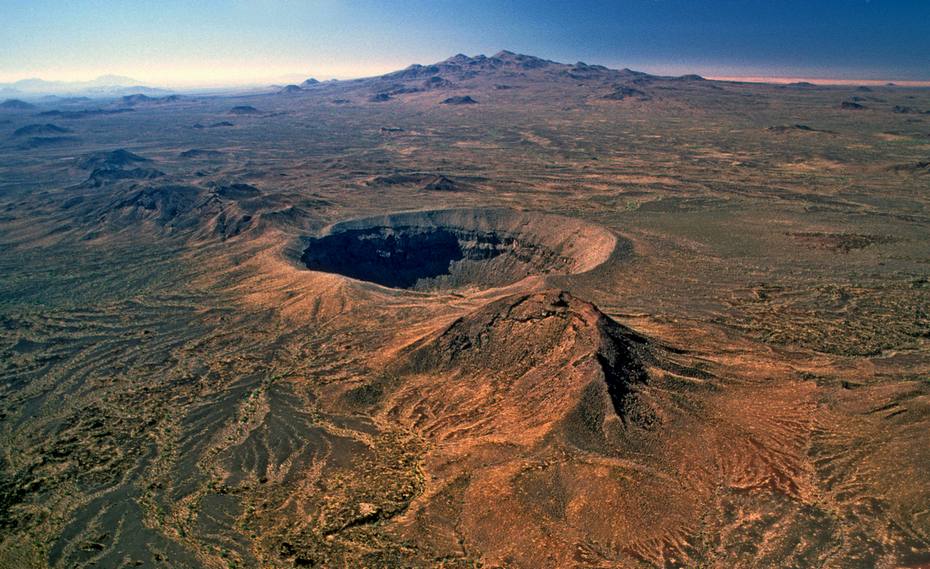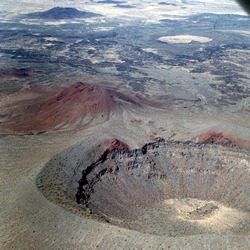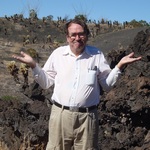

The Pinacate Volcanic Field
Extraordinary basalt volcanism in Northwestern Sonora, Mexico
This giant maar-caldera and the trachyte shield volcano on the horizon are two of the features that make what Sykes called "The Pinacate Lava Fields” extraordinary. Pinacate is a 1500 km oval of Lower Sonoran Desert covered with lava flows and cinders of more than 450 small volcanoes distributed across the area. From space its a landmark at the head of the Gulf of California. These volcanoes are monogenetic; a type of volcano produced by single, short duration (<< 10 years) eruptions that use up all of their modest magma bodies. Monogenetic volcanic fields of Quaternary age like this one are scattered across all the tectonically active regions of the Earth; more than fifty lie within 1000 km of Pinacate.
The trachyte shield could be called a point-source volcano because its low viscosity magmas seem to have erupted through a small summit conduit system and flowed easily outward and downslope to build a volcanic shield. These magmas were evolved from basalt by fractional crystallization and constitute the entire alkaline rock series from basalt to trachyte. It is a kilometer-tall Cerro (mountain) rather than Sierra (range) dotted with younger cone volcanoes like Pinacate Peak, the highest point in the field.
Maar-calderas created by steam activity are common enough to be considered major features of monogenetic volcanic fields; sixteen of those "Fifty Fields" have them. Pinacate has three giants that rival anything in Africa as well as a bunch of smaller ones. All of the Pinacate magmas came through at least some ground water under the field but only about a dozen out of 465 eruptions even noticed the water and interacted with it. Excavating a crater like the one pictured requires Herculean energies; that hole once held half a billion tons of rock and gravel that was ejected by steam explosions. Most of the rock fell into the space formerly occupied by gravel beneath the flows.
One of the small cones, Tecolote, is unique in the world. Much of its surface is covered with bombs of sizes that rival the giants of Germany’s Eifel District. Strong sulfur fumarole activity followed the bomb eruption, indurating some of the bomb-covered surfaces solidly enough to hold vertical scarps when the cone melted and the surface cracked apart along a profusion of faults. The crest of the East Ridge subsided into a graben, and three valleys formed in the South Wall, each at the head of a short lava flow. Tecolote appears to have melted internally but I’ll be damned if I know how.
What is basalt and why is it here?
Basalt rock is frozen basalt magma, a micro-crystalline extrusive rock that commonly also contains both larger crystals (phenocrysts) and gas bubbles (vesicles). Basalt magma in the mantle is a soup of atoms (ions) pried loose from mantle minerals and collected into bodies of sufficient size to migrate unhindered and to punch through the crust. Monogenetic volcanic fields like Pinacate are places where small batches of basalt magma have bored independent conduits to the surface within a well defined area over tens of thousands to millions of years.Click here to explore the "Fifty fields" in Google Earth. Zoom in to look at the volcanoes but don't get lost in looking at the fine detail of things. Remember, you came here for Pinacate.

The dramatic maar-calderas
Most visitors are drawn to Pinacate by these gigantic craters (maar-calderas) blasted into the land surface by powerful steam explosions. The rising magma interacted with ground water beneath older lava flows, flashing it into steam. Most maar-calderas are surrounded by rings of tuff-breccia; a mixture of sand, gravel, old basalt, and distinctive tan-yellow palagonite (hydrated glass which is the quenched magma) expelled from the crater by the explosions. Pinacate's hydrovolcanoes include three giant and six smaller maar-calderas, a large tuff cone, and several composite tuff cones where hydrovolcanism was part of the cone building process but did not dominate.